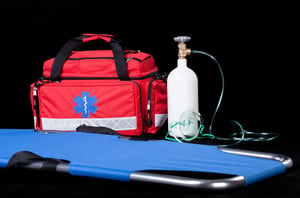The Changing Operational Landscape of Emergency Medical Services
Posted on September 4, 2020 by Rick Harrison
 To the average person, emergency medical services (EMS) always have looked the same, operating in the same way they always have—a 911 call is placed, an ambulance arrives, paramedics or emergency medical technicians (EMTs) assess the situation and provide pre-transport medical care, and the patient is transported to the hospital. What people don’t see are the changes occurring behind the scenes that already have begun to transform EMS delivery.
To the average person, emergency medical services (EMS) always have looked the same, operating in the same way they always have—a 911 call is placed, an ambulance arrives, paramedics or emergency medical technicians (EMTs) assess the situation and provide pre-transport medical care, and the patient is transported to the hospital. What people don’t see are the changes occurring behind the scenes that already have begun to transform EMS delivery.
Pandemic Preparedness
Since the COVID-19 pandemic began, EMS personnel have been, and will remain, on the front lines as we continue to wait for a vaccine to be developed and approved. It is critical that agencies take the steps necessary to protect their personnel now. This includes ensuring an adequate supply of personal protective equipment (PPE), as well as self-monitoring and decontamination policies in place.
It is also crucial that EMS staff have access to mental health services, including stress reduction and emotional support. Employee wellness goes beyond social distancing, mask-wearing, and hand washing guidelines. To best serve the community, EMS staff must be given the tools to protect their physical and emotional well-being. Especially in such uncertain times.
Recruiting, Training, and Retention
In EMS, like in many other areas of public safety, recruiting and retention remain a struggle for many agencies. While it can take anywhere from 90-180 days to recruit, hire, and train an employee before he or she is cleared to operate on the street, it can take just one day to lose them. Agencies are in a constant cycle of recruiting, hiring, and training, but often still struggle to meet the demands of the community.
Employee burnout, high stress, and low pay can make it difficult to retain employees and the constant focus on recruiting, both from a manpower and budgetary standpoint, takes resources that could be used to help improve retention. Agencies need to get creative in order to retain staff. Improved healthcare, competitive salaries, access to mental health services, gym memberships, or bonuses for long-term service are just some examples that can help support retention efforts.
Data and Technology Integration
Technology is a fact of life and an integral part of not just modern medicine, but modern emergency response. At MCP, we talk a lot about data and its potential to improve emergency response when harnessed correctly. But data delivery doesn’t just stop at the emergency communications center. If provided with the right technology, EMS can leverage that data to arrive on scene with more information than ever before.
What is the “right technology?” At a minimum, it means access to onboard computers and smartphones, as well as priority access to cellular or Wi-Fi service, to receive and review data and prepare the appropriate electronic reporting.
Agency Financial Health
Despite being critical to the financial lifecycle of EMS, reimbursement continues to be an ongoing challenge for agencies. No reimbursement means no income, and no income means a nonexistent financial balance—i.e., no way exists to pay personnel, much less , support and sustain operations. Reimbursement does not simply mean reclaiming payment from insurance companies or Medicare. It also includes going to battle for the governance and legislation that address the costs of EMS readiness and, ultimately, service delivery.
The Rise of Community Paramedicine
Patients in many communities often lack access to basic healthcare, frequently relying on 911 and EMS to receive such services in nonemergency situations—which creates an additional burden on already-limited resources within those communities. Community paramedicine is a new healthcare model with the goal of improving access to care by expanding the role of a paramedic or EMT. This is accomplished by enabling them to assist with public health, primary healthcare, and preventive services.
Through implementation of a community paramedicine program, EMS personnel who have completed the appropriate training and educational programs can help reduce the burden on the 911 and EMS communities regarding nonemergency medical care and transport. They also can support their communities by:
- Providing and connecting patients to primary care services
- Completing post-hospital care and follow-up
- Developing and implementing health- promotion and education programs
- Integrating with local public and home healthcare agencies to extend and improve patient care
Like its counterparts in 911, fire service, and law enforcement, EMS is facing a time of great transition. While the COVID-19 pandemic has certainly changed the way EMS agencies operate in terms of preparedness and protocols, many agencies also continue to fight against the same operational challenges they have faced for years. Agencies must also get creative when it comes to care delivery and leveraging resources to support their communities in new ways. The landscape for EMS is changing, whether we can see it or not.
Topics: Operations, Emergency Medical Services


